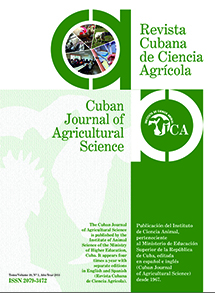Effect of natural shade on the grazing behavior of breeding ewes from Pelibuey breed
Contenido principal del artículo
Resumen
A total of twenty-four breeding ewes from Pelibuey breed were used, divided into two treatments of 12 animals each, to determine the effect of natural shade on the behavior of these animals during grazing. In treatment one, they grazed in the system with natural shade and in treatment two, without shade. Each treatment included the three physiological states: non-pregnant cow, pregnant and lactating. Both groups grazed in two paddocks of natural grasses, of 1.3 ha: one without natural shade, and another with shade from the trees Casuarina equisetifolia (casuarina) and Samanea saman (carob tree).The grazing performance was recorded. Every 10 min., observations during six hours of grazing per day were recorded. Contingency table analysis was used to test the interaction between activities and system type, with and without shade, between activities and day session, and between activities and season for each system, with trees and without them. With the analysis of comparison of proportions (chi square), the time percentages were compared. There was interaction between the activities and the characteristics of the farms, with and without trees, and between the activities and the day session. The animals that had access to
the shade of the trees spent more time grazing-walking. When they grazed with trees, they selected activities in the shade, such as rest and rumination. A higher proportion of grazing time was recorded during the morning session. In the system with trees, the highest proportions of grazing time were obtained in both seasons.
Key words: grazing, trees, animal behavior, silvopastoral system
the shade of the trees spent more time grazing-walking. When they grazed with trees, they selected activities in the shade, such as rest and rumination. A higher proportion of grazing time was recorded during the morning session. In the system with trees, the highest proportions of grazing time were obtained in both seasons.
Key words: grazing, trees, animal behavior, silvopastoral system
Detalles del artículo
Cómo citar
Serrano, J. O., Martínez Melo, J., Herrera, M., Villares, A., Manuel, F. D., Fonseca, N., & Lorenzo, J. C. (2022). Effect of natural shade on the grazing behavior of breeding ewes from Pelibuey breed. Cuban Journal of Agricultural Science, 56(1). Recuperado a partir de https://cjascience.com/index.php/CJAS/article/view/1044
Sección
Ciencia Animal
Aquellos autores/as que tengan publicaciones con esta revista, aceptan los términos siguientes:
- Los autores/as conservarán sus derechos de autor y garantizarán a la revista el derecho de primera publicación de su obra, el cuál estará simultáneamente sujeto a la Licencia Creative Commons Attribution-NonCommercial 4.0 International (CC BY-NC 4.0) que permite a terceros compartir la obra siempre que se indique su autor y su primera publicación esta revista. Bajo esta licencia el autor será libre de:
- Compartir — copiar y redistribuir el material en cualquier medio o formato
- Adaptar — remezclar, transformar y crear a partir del material
- El licenciador no puede revocar estas libertades mientras cumpla con los términos de la licencia
Bajo las siguientes condiciones:
- Reconocimiento — Debe reconocer adecuadamente la autoría, proporcionar un enlace a la licencia e indicar si se han realizado cambios. Puede hacerlo de cualquier manera razonable, pero no de una manera que sugiera que tiene el apoyo del licenciador o lo recibe por el uso que hace.
- NoComercial — No puede utilizar el material para una finalidad comercial.
- No hay restricciones adicionales — No puede aplicar términos legales o medidas tecnológicas que legalmente restrinjan realizar aquello que la licencia permite.
- Los autores/as podrán adoptar otros acuerdos de licencia no exclusiva de distribución de la versión de la obra publicada (p. ej.: depositarla en un archivo telemático institucional o publicarla en un volumen monográfico) siempre que se indique la publicación inicial en esta revista.
- Se permite y recomienda a los autores/as difundir su obra a través de Internet (p. ej.: en archivos telemáticos institucionales o en su página web) antes y durante el proceso de envío, lo cual puede producir intercambios interesantes y aumentar las citas de la obra publicada. (Véase El efecto del acceso abierto).
